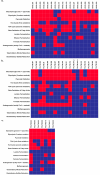Comparative metagenomics of tropical reef fishes show conserved core gut functions across hosts and diets with diet-related functional gene enrichments
- PMID: 39840973
- PMCID: PMC11837501
- DOI: 10.1128/aem.02229-24
Comparative metagenomics of tropical reef fishes show conserved core gut functions across hosts and diets with diet-related functional gene enrichments
Abstract
Fish gut microbial communities are important for the breakdown and energy harvesting of the host diet. Microbes within the fish gut are selected by environmental and evolutionary factors. To understand how fish gut microbial communities are shaped by diet, three tropical fish species (hawkfish, Paracirrhites arcatus; yellow tang, Zebrasoma flavescens; and triggerfish, Rhinecanthus aculeatus) were fed piscivorous (fish meal pellets), herbivorous (seaweed), and invertivorous (shrimp) diets, respectively. From fecal samples, a total of 43 metagenome assembled genomes (MAGs) were recovered from all fish diet treatments. Each host-diet treatment harbored distinct microbial communities based on taxonomy, with Proteobacteria, Bacteroidota, and Firmicutes being the most represented. Based on their metagenomes, MAGs from all three host-diet treatments demonstrated a baseline ability to degrade proteinaceous, fatty acid, and simple carbohydrate inputs and carry out central carbon metabolism, lactate and formate fermentation, acetogenesis, nitrate respiration, and B vitamin synthesis. The herbivorous yellow tang harbored more functionally diverse MAGs with some complex polysaccharide degradation specialists, while the piscivorous hawkfish's MAGs were more specialized for the degradation of proteins. The invertivorous triggerfish's gut MAGs lacked many carbohydrate-degrading capabilities, resulting in them being more specialized and functionally uniform. Across all treatments, several MAGs were able to participate in only individual steps of the degradation of complex polysaccharides, suggestive of microbial community networks that degrade complex inputs.
Importance: The benefits of healthy microbiomes for vertebrate hosts include the breakdown of food into more readily usable forms and production of essential vitamins from their host's diet. Compositions of microbial communities in the guts of fish in response to diet have been studied, but there is a lack of a comprehensive understanding of the genome-based metabolic capabilities of specific microbes and how they support their hosts. Therefore, we assembled genomes of several gut microbes collected from the feces of three fish species that were being fed different diets to illustrate how individual microbes can carry out specific steps in the degradation and energy utilization of various food inputs and support their host. We found evidence that fish gut microbial communities share several core functions despite differences in microbial taxonomy. Herbivorous fish harbored a functionally diverse microbial community with plant matter degraders, while the piscivorous and invertivorous fish had microbiomes more specialized in protein degradation.
Keywords: fish gut; herbivore; invertivore; metagenome; piscivore.
Conflict of interest statement
The authors declare no conflict of interest.
Figures





Update of
-
Comparative metagenomics of tropical reef fishes show conserved core gut functions across hosts and diets with diet-related functional gene enrichments.bioRxiv [Preprint]. 2024 Nov 12:2024.05.21.595191. doi: 10.1101/2024.05.21.595191. bioRxiv. 2024. Update in: Appl Environ Microbiol. 2025 Feb 19;91(2):e0222924. doi: 10.1128/aem.02229-24. PMID: 38826274 Free PMC article. Updated. Preprint.
Similar articles
-
Comparative metagenomics of tropical reef fishes show conserved core gut functions across hosts and diets with diet-related functional gene enrichments.bioRxiv [Preprint]. 2024 Nov 12:2024.05.21.595191. doi: 10.1101/2024.05.21.595191. bioRxiv. 2024. Update in: Appl Environ Microbiol. 2025 Feb 19;91(2):e0222924. doi: 10.1128/aem.02229-24. PMID: 38826274 Free PMC article. Updated. Preprint.
-
Enrichable consortia of microbial symbionts degrade macroalgal polysaccharides in Kyphosus fish.mBio. 2024 May 8;15(5):e0049624. doi: 10.1128/mbio.00496-24. Epub 2024 Mar 27. mBio. 2024. PMID: 38534158 Free PMC article.
-
Taxonomic, Genomic, and Functional Variation in the Gut Microbiomes of Wild Spotted Hyenas Across 2 Decades of Study.mSystems. 2023 Feb 23;8(1):e0096522. doi: 10.1128/msystems.00965-22. Epub 2022 Dec 19. mSystems. 2023. PMID: 36533929 Free PMC article.
-
A review on comparative analysis of marine and freshwater fish gut microbiomes: insights into environmental impact on gut microbiota.FEMS Microbiol Ecol. 2025 Jan 7;101(1):fiae169. doi: 10.1093/femsec/fiae169. FEMS Microbiol Ecol. 2025. PMID: 39719366 Free PMC article. Review.
-
Harnessing gut microbial communities to unravel microbiome functions.Curr Opin Microbiol. 2025 Feb;83:102578. doi: 10.1016/j.mib.2024.102578. Epub 2025 Jan 8. Curr Opin Microbiol. 2025. PMID: 39787728 Review.
Cited by
-
Shotgun metagenomics analysis of gut microbiota of three indigenous fish species from the Kizil River, Xinjiang.Front Microbiol. 2025 Jun 24;16:1617701. doi: 10.3389/fmicb.2025.1617701. eCollection 2025. Front Microbiol. 2025. PMID: 40630181 Free PMC article.
References
-
- Nayak SK. 2010. Role of gastrointestinal microbiota in fish. Aquac Res 41:1553–1573. doi:10.1111/j.1365-2109.2010.02546.x - DOI
-
- Yukgehnaish K, Kumar P, Sivachandran P, Marimuthu K, Arshad A, Paray BA, Arockiaraj J. 2020. Gut microbiota metagenomics in aquaculture: factors influencing gut microbiome and its physiological role in fish. Rev Aquacult 12:1903–1927. doi:10.1111/raq.12416 - DOI
-
- Reid HI, Treasurer JW, Adam B, Birkbeck TH. 2009. Analysis of bacterial populations in the gut of developing cod larvae and identification of Vibrio logei, Vibrio anguillarum and Vibrio splendidus as pathogens of cod larvae. Aquaculture 288:36–43. doi:10.1016/j.aquaculture.2008.11.022 - DOI
-
- Arockiaraj J, Kumaresan V, Chaurasia MK, Bhatt P, Palanisamy R, Pasupuleti M, Gnanam AJ, Kasi M. 2014. Molecular characterization of a novel cathepsin B from striped murrel Channa striatus: bioinformatics analysis, gene expression, synthesis of peptide and antimicrobial property. Turk J Fish Aquat Sc 14:379–389. doi:10.4194/1303-2712-v14_2_08 - DOI
Publication types
MeSH terms
Grants and funding
LinkOut - more resources
Full Text Sources

